The pathogenicity determinant of Citrus tristeza virus causing the seedling yellows syndrome maps at the 3'-terminal region of the viral genome
- PMID: 20078776
- PMCID: PMC6640426
- DOI: 10.1111/j.1364-3703.2009.00572.x
The pathogenicity determinant of Citrus tristeza virus causing the seedling yellows syndrome maps at the 3'-terminal region of the viral genome
Abstract
Citrus tristeza virus (CTV) (genus Closterovirus, family Closteroviridae) causes some of the more important viral diseases of citrus worldwide. The ability to map disease-inducing determinants of CTV is needed to develop better diagnostic and disease control procedures. A distinctive phenotype of some isolates of CTV is the ability to induce seedling yellows (SY) in sour orange, lemon and grapefruit seedlings. In Florida, the decline isolate of CTV, T36, induces SY, whereas a widely distributed mild isolate, T30, does not. To delimit the viral sequences associated with the SY syndrome, we created a number of T36/T30 hybrids by substituting T30 sequences into different regions of the 3' half of the genome of an infectious cDNA of T36. Eleven T36/T30 hybrids replicated in Nicotiana benthamiana protoplasts. Five of these hybrids formed viable virions that were mechanically transmitted to Citrus macrophylla, a permissive host for CTV. All induced systemic infections, similar to that of the parental T36 clone. Tissues from these C. macrophylla source plants were then used to graft inoculate sour orange and grapefruit seedlings. Inoculation with three of the T30/T36 hybrid constructs induced SY symptoms identical to those of T36; however, two hybrids with T30 substitutions in the p23-3' nontranslated region (NTR) (nucleotides 18 394-19 296) failed to induce SY. Sour orange seedlings infected with a recombinant non-SY p23-3' NTR hybrid also remained symptomless when challenged with the parental virus (T36), demonstrating the potential feasibility of using engineered constructs of CTV to mitigate disease.
Figures
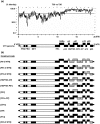
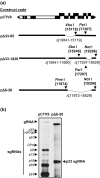


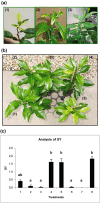
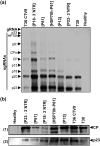
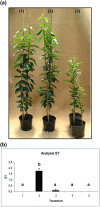
Similar articles
-
Replication of heterologous combinations of helper and defective RNA of citrus tristeza virus.Virology. 2000 Feb 15;267(2):360-9. doi: 10.1006/viro.1999.0128. Virology. 2000. PMID: 10662631
-
Progress in Our Understanding of the Cross-Protection Mechanism of CTV-VT No-SY Isolates Against Homologous SY Isolates.Pathogens. 2025 Jul 16;14(7):701. doi: 10.3390/pathogens14070701. Pathogens. 2025. PMID: 40732747 Free PMC article.
-
Viral-like symptoms induced by the ectopic expression of the p23 gene of Citrus tristeza virus are citrus specific and do not correlate with the pathogenicity of the virus strain.Mol Plant Microbe Interact. 2005 May;18(5):435-45. doi: 10.1094/MPMI-18-0435. Mol Plant Microbe Interact. 2005. PMID: 15915642
-
Citrus tristeza virus: a pathogen that changed the course of the citrus industry.Mol Plant Pathol. 2008 Mar;9(2):251-68. doi: 10.1111/j.1364-3703.2007.00455.x. Mol Plant Pathol. 2008. PMID: 18705856 Free PMC article. Review.
-
Complex interplay: The interactions between citrus tristeza virus and its host.Virology. 2025 Feb;603:110388. doi: 10.1016/j.virol.2024.110388. Epub 2025 Jan 2. Virology. 2025. PMID: 39787773 Review.
Cited by
-
Past and future of a century old Citrus tristeza virus collection: a California citrus germplasm tale.Front Microbiol. 2013 Dec 10;4:366. doi: 10.3389/fmicb.2013.00366. eCollection 2013. Front Microbiol. 2013. PMID: 24339822 Free PMC article.
-
Symptoms induced by transgenic expression of p23 from Citrus tristeza virus in phloem-associated cells of Mexican lime mimic virus infection without the aberrations accompanying constitutive expression.Mol Plant Pathol. 2015 May;16(4):388-99. doi: 10.1111/mpp.12188. Epub 2014 Oct 1. Mol Plant Pathol. 2015. PMID: 25171669 Free PMC article.
-
Applying infectious clones and untargeted metabolite profiling to characterize citrus tristeza virus-induced stem pitting in citrus.Sci Rep. 2024 Nov 18;14(1):28490. doi: 10.1038/s41598-024-79402-2. Sci Rep. 2024. PMID: 39557999 Free PMC article.
-
The p19.7 RNA silencing suppressor from Grapevine leafroll-associated virus 3 shows different levels of activity across phylogenetic groups.Virus Genes. 2012 Oct;45(2):333-9. doi: 10.1007/s11262-012-0772-3. Epub 2012 Jun 20. Virus Genes. 2012. PMID: 22714284
-
Protein-protein interactions between proteins of Citrus tristeza virus isolates.Virus Genes. 2014 Dec;49(3):456-65. doi: 10.1007/s11262-014-1100-x. Epub 2014 Jul 27. Virus Genes. 2014. PMID: 25064367
References
-
- Albiach‐Martí, M.R. , Guerri, J. , Cambra, M. , Garnsey, S.M. and Moreno, P. (2000a) Differentiation of citrus tristeza virus isolates by serological analysis of the p25 coat protein peptide maps. J. Virol. Methods, 88, 25–34. - PubMed
-
- Albiach‐Martí, M.R. , Guerri, J. , Hermoso de Mendoza, A. , Laigret, F. , Ballester‐Olmos, J.F. and Moreno, P. (2000b) Aphid transmission alters the genomic and defective RNA populations of citrus tristeza virus. Phytopathology, 90, 134–138. - PubMed
-
- Albiach‐Martí, M.R. , Mawassi, M. , Gowda, S. , Satyanarayana, T. , Hilf, M.E. , Shanker, S. , Almira, E.C. , Vives, M.C. , López, C. , Guerri, J. , Flores, R. , Moreno, P. , Garnsey, S.M. and Dawson, W.O. (2000c) Sequences of Citrus tristeza virus separated in time and space are essentially identical. J. Virol. 74, 6856–6865. - PMC - PubMed
-
- Bar‐Joseph, M. and Dawson, W.O. (2008) Citrus tristeza virus In: Encyclopedia of Virology, Vol. 1 (Mahy B.W.J. and Van Regenmortel M.H.V., eds), pp. 520–525. Oxford: Elsevier Ltd.
-
- Bar‐Joseph, M. , Marcus, R. and Lee, R.F. (1989) The continuous challenge of citrus tristeza virus control. Annu. Rev. Phytopathol. 27, 291–316.
Publication types
MeSH terms
LinkOut - more resources
Full Text Sources

